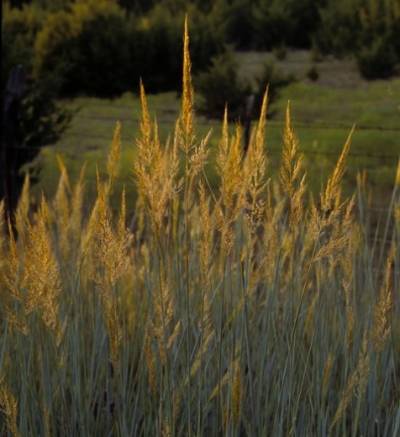Indian Grass
 This native grass is putting on quite a show right now with its gorgeous seed heads on full display. Indian grass is considered one of the “Big Three” of the native grasses along with Big Bluestem and Switchgrass. These grasses grow in the Tall Grass prairie which historically stretched from Illinois west to Kansas and from Minnesota south to Texas with approximately 4 to 13% of the original prairie remaining. The scientific name, Sorghastrum nutans, perfectly describes this grass with the genus name meaning “imitation of sorghum” and the species meaning “swaying” as the seed head swaying in the wind looks similar to sorghum (milo) swaying in the wind. Indian grass is a tall bunch grass reaching heights from 3 to 8 feet depending on the soil with broad blue-green leaf blades that turn orange to purple in the fall giving it multiple seasons of interest in the landscape. The seed head is large, soft, and plume-like with a yellow to gold color. Indian grass prefers lowland soils and tolerates some flooding in its native range but it also grows rocky poor soils and handles drought and heat conditions. This grass is a wonderful addition to any landscape and pollinator garden. Remember that it will slowly spread so give it space to grow for best results. Indian grass is wonderful for wildlife with birds eating on the seed heads and it is also resistant to deer browsing even though it is loved by cattle. This native does not do well in shade and may flop over in very moist and rich soils. Cut the grass down in the spring right before it starts growing as the leaves will help protect the crown through the winter.
This native grass is putting on quite a show right now with its gorgeous seed heads on full display. Indian grass is considered one of the “Big Three” of the native grasses along with Big Bluestem and Switchgrass. These grasses grow in the Tall Grass prairie which historically stretched from Illinois west to Kansas and from Minnesota south to Texas with approximately 4 to 13% of the original prairie remaining. The scientific name, Sorghastrum nutans, perfectly describes this grass with the genus name meaning “imitation of sorghum” and the species meaning “swaying” as the seed head swaying in the wind looks similar to sorghum (milo) swaying in the wind. Indian grass is a tall bunch grass reaching heights from 3 to 8 feet depending on the soil with broad blue-green leaf blades that turn orange to purple in the fall giving it multiple seasons of interest in the landscape. The seed head is large, soft, and plume-like with a yellow to gold color. Indian grass prefers lowland soils and tolerates some flooding in its native range but it also grows rocky poor soils and handles drought and heat conditions. This grass is a wonderful addition to any landscape and pollinator garden. Remember that it will slowly spread so give it space to grow for best results. Indian grass is wonderful for wildlife with birds eating on the seed heads and it is also resistant to deer browsing even though it is loved by cattle. This native does not do well in shade and may flop over in very moist and rich soils. Cut the grass down in the spring right before it starts growing as the leaves will help protect the crown through the winter.

